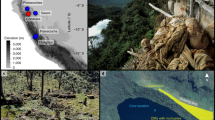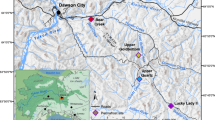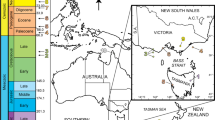Abstract
Tansley1 erected the hypothesis that the grasslands of the British chalk were the product of neolithic human forest clearance although he did not discount the possibility that in some areas the grasslands might have persisted throughout the forest period. Pigott and Walters2 suggested a range of calcareous habitats where forests perhaps failed to form a closed canopy: where erosion was rapid, slopes steep, or soils too thin for trees to root. Despite these exceptions, most authors describe chalk grasslands as the product of neolithic clearance (for example, refs 3 and 4). The debate has been starved of evidence until now by the almost total lack of Flandrian botanical data from sites actually on the chalk. Here we summarize the results of a broad palaeoecological study (using pollen, and plant and animal macrofossils) of a site in the heart of the Yorkshire Wolds which has yielded the first late-glacial and early Flandrian pollen record from the British chalk5. This deposit has provided evidence of early Flandrian chalk grasslands and of their persistence throughout the Pre-Boreal and Boreal periods.
This is a preview of subscription content, access via your institution
Access options
Subscribe to this journal
Receive 51 print issues and online access
$199.00 per year
only $3.90 per issue
Buy this article
- Purchase on Springer Link
- Instant access to full article PDF
Prices may be subject to local taxes which are calculated during checkout
Similar content being viewed by others
References
Tansley, A. G. The Vegetation of the British Isles (Cambridge University Press, 1939).
Pigott, C. D. & Walters, S. M. J. Ecol. 42, 95–117 (1954).
Smith, C. J. The Ecology of the English Chalk (Academic, London, 1980).
Waton, P. V. thesis, Univ. Southampton, 1982).
Bush, M. B. thesis, Univ. Hull, 1986).
Lewin, S. Univ. Hull. occ. Pap. Geogr. 11, 1–89 (1969).
Faegri, K. & Iversen, J. A Textbook of Pollen Analysis (1975).
Tomlinson, P. Circaea 2, 139–141 (1984).
Kenward, H. K., Hall, A. R. & Jones, A. K. G. Sci. Archaeol. 22, 3–15 (1984).
Godwin, H. The History of the British Flora 2nd edn (Cambridge University Press, 1975).
Mellars, P. CBA Res. Rep. 11, 49–56 (1975).
Evans, J. G. & Dimbleby, G. W. Proc. prehist. Soc. 42, 150–159 (1976).
Manby, T. G. Yorks archaeol. J. 47, 23–61 (1975).
Author information
Authors and Affiliations
Rights and permissions
About this article
Cite this article
Bush, M., Flenley, J. The age of the British chalk grassland. Nature 329, 434–436 (1987). https://doi.org/10.1038/329434a0
Received:
Accepted:
Issue Date:
DOI: https://doi.org/10.1038/329434a0
This article is cited by
-
Chalk grasslands in the ice age
Nature (1987)
Comments
By submitting a comment you agree to abide by our Terms and Community Guidelines. If you find something abusive or that does not comply with our terms or guidelines please flag it as inappropriate.



